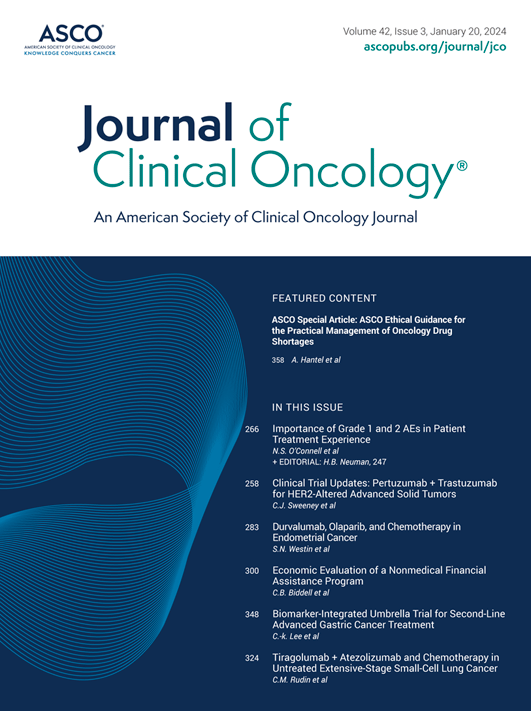优化输液中心使用静脉注射西替利嗪预防超敏输液反应的椅子时间。
IF 42.1
1区 医学
Q1 ONCOLOGY
引用次数: 0
摘要
背景:肿瘤输液中心越来越注重提高操作效率和患者满意度,同时保持高质量的护理。一个关键组成部分是优化椅子时间,这在COVID-19大流行期间对患者安全尤其重要,可以减少传播风险。许多输注需要预先服用抗组胺药,以减少超敏输注反应(IRs)的风险。两种静脉注射方案是静脉注射苯海拉明和静脉注射西替利嗪,它们比口服方案起效更快,可以静脉注射。在治疗急性荨麻疹时,静脉注射西替利嗪被证明与静脉注射苯海拉明相当,副作用更少,并且它可能有效地预防静坐时间延长的IRs。方法:一项随机、双盲的2期研究对34例接受紫杉醇、利妥昔单抗、其生物类似药或obinutuzumab治疗的患者(第一个周期、6个月后再治疗或持续ir)进行了单剂量西替利嗪10mg与静脉注射苯海拉明50mg的药物前治疗进行了评估。主要目的是研究药物前治疗后IRs的发生率。次要终点包括抗组胺药引起的镇静和出院准备时间。患者报告镇静程度为0-4(0 =无至4 =极度严重)。考虑到研究的探索性,没有计划进行正式的统计分析。结果:在2020年3月25日至11月23日COVID-19大流行期间,纳入了主要患有癌症的成人(n = 31[91%])。静脉注射西替利嗪组和苯海拉明组的中位年龄分别为65岁和67岁。静脉注射西替利嗪和静脉注射苯海拉明分别为2/17(11.8%)和3/17(17.6%)。与静脉注射苯海拉明组相比,静脉注射西替利嗪组的平均镇静评分在所有时间点(包括出院时)都较低(分别为0.1和0.4)。静脉注射西替利嗪(4.3小时[1.5])比静脉注射苯海拉明(4.7小时[1.2])平均出院时间少24分钟。这种差异在≥65岁的患者中更大(少30分钟)(4.4[1.3]对4.9[1.0]小时)。无论患者接受的是紫杉醇(n = 9)还是抗cd20 (n = 25),当预先给予静脉注射西替利齐时,患者的静坐时间都更短。静脉注射西替利嗪(2例)比静脉注射苯海拉明(4例)更少出现与治疗相关的不良事件。结论:这是第一个随机对照试验,评估静脉抗组胺预用药对IRs和椅子时间的影响。研究表明,与静脉注射苯海拉明相比,静脉注射西替利嗪可以预防IRs,镇静作用更小,相关ae更少,静坐时间更短。这改善了输液中心的操作和患者体验。临床试验信息:NCT04189588。本文章由计算机程序翻译,如有差异,请以英文原文为准。
Optimizing chair time in infusion centers using intravenous cetirizine premedication for the prevention of hypersensitivity infusion reactions.
e13508 Background: Oncology infusion centers are increasingly focused on improving operational efficiencies and patient satisfaction, while maintaining quality care. One key component is optimizing chair time, which has been especially important for patient safety during the COVID-19 pandemic to reduce risk of transmission. Many infusions require antihistamine premedication to reduce the risk of hypersensitivity infusion reactions (IRs). The two IV options are IV diphenhydramine and IV cetirizine, which have a quicker onset than oral options and can be administered IV push. In treating acute urticaria, IV cetirizine was shown to be comparable to IV diphenhydramine, with fewer side effects, and it may be effective for preventing IRs with improved chair time. Methods: A randomized, double-blind phase 2 study evaluating premedication with single dose IV cetirizine 10 mg versus IV diphenhydramine 50 mg was conducted in 34 patients receiving paclitaxel, rituximab, its biosimilar or obinutuzumab (first cycle, retreatment after 6 months or with persistent IRs). The primary objective was the incidence of IRs after premedication. Secondary endpoints included sedation due to antihistamines and time to readiness for discharge. Sedation was reported by patients on a scale of 0-4 (0 = none to 4 = extremely severe). No formal statistical analyses were planned given the exploratory nature of the study. Results: Adults primarily with cancer (n = 31 [91%]) were enrolled during the COVID-19 pandemic, from March 25 to November 23, 2020. The median age was 65 and 67 years in the IV cetirizine and diphenhydramine groups, respectively. The number of patients with IRs was 2/17 (11.8%) with IV cetirizine versus 3/17 (17.6%) with IV diphenhydramine. The mean sedation score in the IV cetirizine group compared to the IV diphenhydramine group was lower at all time points, including at discharge (0.1 vs 0.4, respectively). Mean time to discharge was 24 minutes less with IV cetirizine (4.3 hours [1.5]) versus IV diphenhydramine (4.7 hours [1.2]). This difference was greater (30 minutes less) in those ≥65 years of age (4.4 [1.3] vs 4.9 [1.0] hours). Regardless of whether patients received paclitaxel (n = 9) or an anti-CD20 (n = 25), patients had less chair time when premedicated with IV cetirizine. There were fewer treatment-related adverse events (AEs) with IV cetirizine (2 events) than with IV diphenhydramine (4 events). Conclusions: This was the first randomized, controlled trial evaluating IV antihistamine premedication for IRs and chair time. It was shown that IV cetirizine can prevent IRs, with less sedation, fewer related AEs and reduced chair time compared to IV diphenhydramine. This improves infusion center operations and patient experience. Clinical trial information: NCT04189588.
求助全文
通过发布文献求助,成功后即可免费获取论文全文。
去求助
来源期刊

Journal of Clinical Oncology
医学-肿瘤学
CiteScore
41.20
自引率
2.20%
发文量
8215
审稿时长
2 months
期刊介绍:
The Journal of Clinical Oncology serves its readers as the single most credible, authoritative resource for disseminating significant clinical oncology research. In print and in electronic format, JCO strives to publish the highest quality articles dedicated to clinical research. Original Reports remain the focus of JCO, but this scientific communication is enhanced by appropriately selected Editorials, Commentaries, Reviews, and other work that relate to the care of patients with cancer.
 求助内容:
求助内容: 应助结果提醒方式:
应助结果提醒方式:


